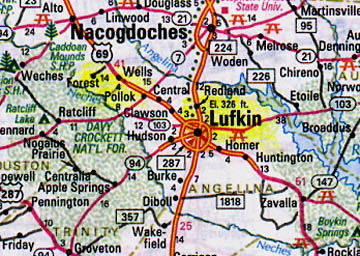
October 20, 2004 Pollok, Texas – I have been receiving dozens of e-mails from people around the world concerning the Pollok animal that some refer to as a “Chupa,” after the chupacabra mystery in Puerto Rico in the mid-1990s. The most common explanation has been a coyote with mange. Manuel and Tammi Rego sent the photograph below of a mangy coyote shot in the ribs.
When you compare the known mangy coyote with the animal shot in Pollok, Texas, there are similarities. The strange Elmendorf animal with the spots on its body shot in May 2004, is also shown below.
This week, BBC news in England reported that a “mystery creature” was photographed in Lisvane, a suburb of northern Cardiff. The Welsh Mountain Zoo’s Zoological Director said it might be a “young kangaroo.” The body was described as grey with a pointed nose, resembling somewhat the body shapes of the Elmendorf and Pollok creatures.
Several others insist the Pollok and Elmendorf animals must be Xoloitzquintle, Mexican hairless dogs. See 07-31-04 Earthfiles. Many people have also e-mailed about the Tasmanian Tiger, Thylacine, which is supposed to be extinct and has stripes. You can compare the dogs and tiger from the photographs below.
Coyote With Mange
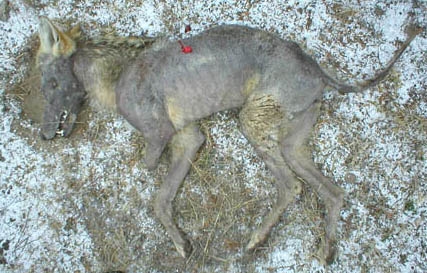
Red Fox With Sarcoptic Mange
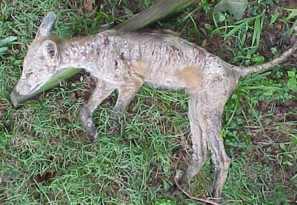
Sarcoptic mange, commonly know as scabies, is caused by microscopic mites called Notoedres that burrows deep into the skin. It is contagious to other pets and occurs in many different animals. It causes intense itchiness, especially affecting the ear margins, elbows, and face. People can pick up this disease from their pet and show symptoms of itching, but it goes away by itself in a short time and does not require treatment in most cases.
Pollok, Texas Unidentified Animal Shot on October 8, 2004
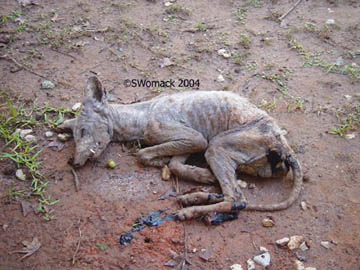
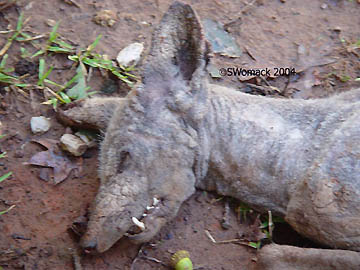
Elmendorf, Texas Unidentified Animal Shot in May 2004
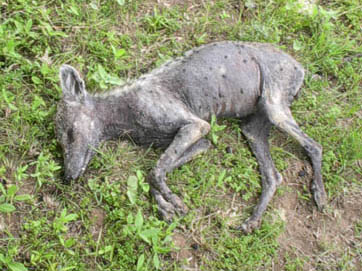
Unidentified Animal in Lisvane, Cardiff, British Isles
Photographed on October 14, 2004
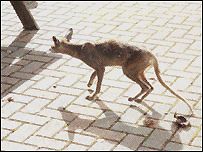
Xoloitzquintle, Mexican Hairless Dog
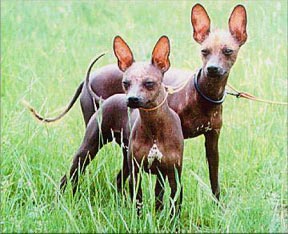
Tasmanian Tiger, Thylacine
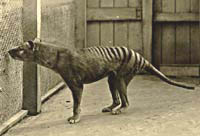
The Thylacine (Thylacinus cynocephalus, dog-headed pouched-dog) is a large carnivorous marsupial now believed to be extinct. It is the single member of the family Thylacinidae. It is also known as the Tasmanian Tiger or Tasmanian Wolf.
E-mails:
1) October 19, 2004
“I am an Assistant District Attorney in Bexar County, San Antonio, Texas, and have followed your work for years. Today our Judge, who has extensive experience with dogs (he raises Brittany Spaniels) remarked in court that the ‘chupacabras’ in Elmendorf and East Texas (Pollok) were nothing more than coyotes with ‘Sarcophagus Mange, according to a vet friend of his.”
2) October 19, 2004
From Neuropathology researcher in Dallas, Texas: “My colleague sent your Earthfiles link to me. We are most interested to hear the genetic analysis results and to find what gender the deceased animals are. Let us know if you will post to Earthfiles? This has really caught our interests as animal lovers and scientists.”
3) October 18, 2004
“I thought I would write to let you know I have seen the strange creature in Oakville, Ontario, Canada as well. The pictures and descriptions match exactly the description I gave my friends and family trying to make them understand this strange animal I had seen. It is difficult in your heart you know what you have seen, but your brain has trouble because you can’t categorize it because it is unlike anything you have ever heard of or seen before. Everyone chalked it up to a genetically messed up, mangy coyote. Yet, another lady and myself who had both seen it on different occasions knew it was different.
“I am a perfectly healthy, sane 31-year-old divorced mother of one, who works for my father’s company. I have seen this creature on two different occasions and there is no mistaking it. I also have a lot of experience working with animals and am familiar with wolves/coyote/foxes/deer. What I saw was none of those. It was exactly what you see in the pictures you show. I don’t know if I should be glad or concerned that there are more of them out there. It was truly bizarre. Not to mention everyone thought I was nuts (except for the other lady that saw it) because in their minds how could something like that I was describing exist, especially around here without people knowing about it? At least I feel better knowing that other people have seen it, too, and that they know what it’s like to know what you have seen but have no one able or willing to believe you. If I hadn’t seen it with my own eyes, I’d probably be skeptical, too.
It’s a little hard to believe that you could see a creature around here that reminds you of a deer/coyote/jackal/hyena/Mexican hairless, all in one.”
4) October 20, 2004
“I forwarded the link to the photo of the “Lufkin Animal” to my Showdogs-L email list. We are a large group of dog fanciers from all over the world. Some folks thought this might be a Xolocuintli, or large Mexican hairless dog. It was obviously not well cared for, and as David says they are found in the wild on occasion, and can automatically be registered with the Mexican Kennel Club if captured.
WOW!!!!! They should contact the Mexican KC.
That does look like a Xolo, in severe poor condition and indeed, severe over bite. It is said that even up to recent years they still were found in the wild. I don’t know of any specific case, but if you get one out of the blue, theMexican KC will give you automatic full registration.”
More Information:
Please see other Earthfiles reports in the Earthfiles Archive:
- 10/14/2004 — Another “Chupacabra” Shot in Texas
- 07/31/2004 — Strange Animal Shot by Elmendorf, Texas Farmer
- 07/19/2002 — Unusual Animal Deaths and Unidentified Aerial Lights in Argentina
- 06/15/2002 — Cattle Mutilations In LaPampa, Argentina
- 06/01/1999 — Puncture Wounds On Dogs In Woodleaf, North Carolina
© 1998 - 2025 by Linda Moulton Howe.
All Rights Reserved.

